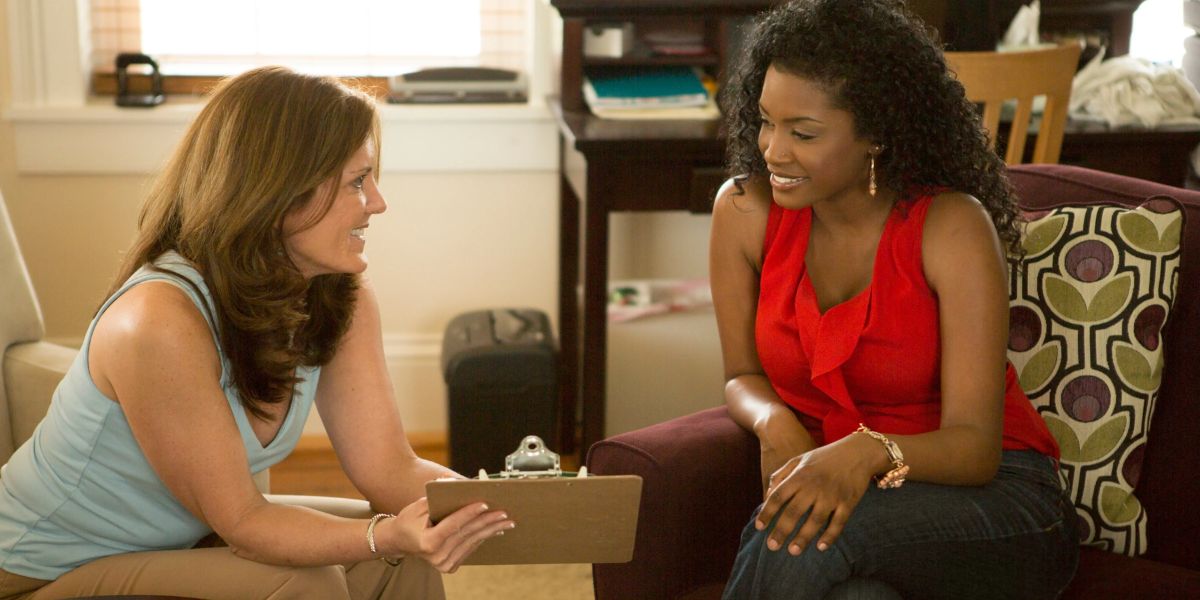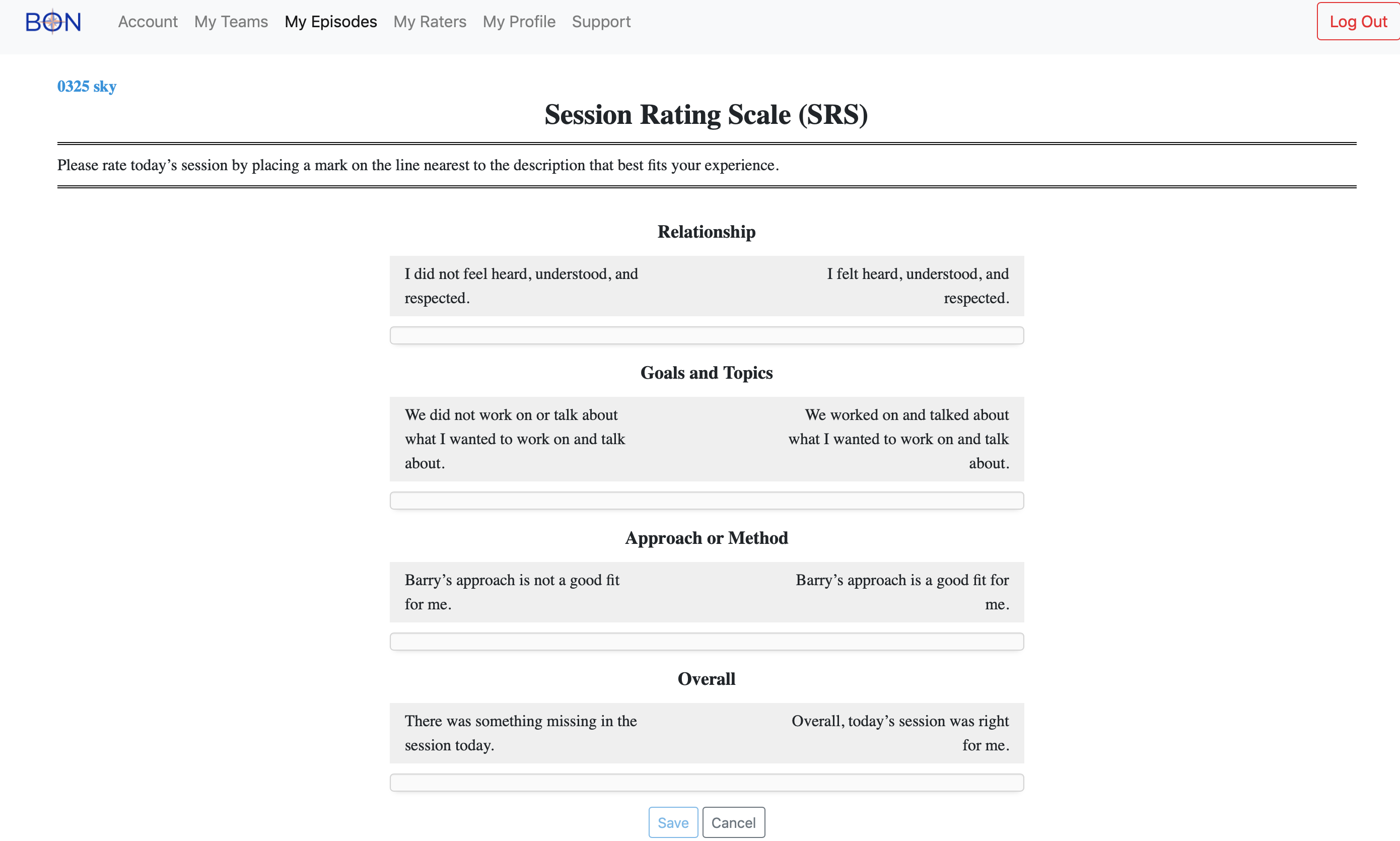June 28, 2022 12:03 PM
If you don’t have BON, the SRS (Download the paper and pencil form) is easily scored by measuring the client’s marks on the line in a similar fashion as the Outcome Rating Scale (ORS). Each line is 10 centimeters long.
To begin the discussion, just pick up on an item or two on the SRS and make comment based on the following. If there are any scores lower than 9 centimeters, or any scale lower than the others, follow up on it. A total score of less than 36 should be discussed. Keep in mind that children and adolescents show more variability of scores than adults, and it is likely that when there is a problem with the alliance, the score will drop dramatically. Children and adolescents are far less likely to be reluctant to let practitioners know that something is amiss. The best thing that the SRS can do for you is to allow you to fix any alliance problems that are developing

The SRS shows clients that you do more than talk the talk—you are REALLY interested in their feedback and want to know what they think.
The cutoff of 36 may be a bit of overkill given the average first meeting SRS scores range from 33.5 to 33.9 and increase from there. But given the importance of the alliance, erring on the side of caution is warranted. Moreover, exploration of the alliance in and of itself helps build the alliance. So if a client scores less than a total of 36, or less than 9 cm on any dimension on the SRS, or one scale is lower than the others, there is a potential problem that should be discussed, as well as an opportunity to enhance your relationship. Given these parameters, you can do a very quick visual check and then integrate the results into the conversation.
This is not complicated or heavy-handed. There are only two choices. Either the SRS is 36 or above, or not. And your actions are equally simple: Either you thank the client for the feedback and invite them to share any future concerns—letting them know it’s the best favor they could do for you; or you thank the client for the feedback, and explore why the ratings are a bit lower so that you can try to fit what they are asking for. But don’t stress about it. Remain open and keep encouraging the client to let you know if there’s anything else you can do. But don’t think for a minute that you will get critical feedback from everyone. Some clients will never do it.
A high rating is a good thing but can be difficult to interpret unless you unfold it a bit more. A lower rating is cause for celebration and can yield information that makes the difference between success and failure.

Good initial alliances that stay good portend a positive outcome, but those that start off lower and improve over time are even more robust predictors. The SRS provides a structure to systematically address the alliance, gives you a chance to fix any problems, and demonstrates that you do more than give lip service to forming good relationships. Your appreciation of any negative feedback is a powerful alliance builder.
Thanking and Inviting: Let me just take a second here to look at this SRS—it’s kind of like a thermometer that takes the temperature of our meeting here today. Wow, great, looks like we are on the same page, that we are talking about what you think is important and you believe today’s meeting was right for you. Please let me know if I get off track, because letting me know would be the biggest favor you could do for me. Is there anything in particular that you found helpful today that you want to make sure I continue?
The idea here is simply to say thanks and continue to invite any feedback to improve the service. Getting at what the client liked about the session can also be useful. Anything that helps a conversation about the alliance is good. As you gain experience with using the SRS, you will figure out more ways to have conversations about the alliance in a way that increases client engagement and partnership.
How about when it falls below 36 or any individual scale is below 9? The only difference in your response is that you thank and explore, instead of thank and invite. Don’t be expecting specific feedback or grand revelations, although they do happen from time to time. Usually the feedback is somewhat vague and general. Remember it is hard, for nearly all of us, to give interpersonal feedback, especially critical; so any feedback is communicating something. Just try to get at what it is. “Is there anything else I could have done differently, something I should have done more of or less of, some question or topic I should have asked but didn’t?” Another useful question is, “Do you have any advice for me for next time, anything that would make it a little better?”
Thanking and Exploring: Let me quickly look at this other form here that lets me know how you think we are doing. Okay, seems like it could have gone better. Thanks very much for your honesty and giving me a chance to address what I can do differently. Was there something else I should have asked you about or should have done to make this meeting work better for you? What was missing here?
Clients may say that nobody’s perfect and that’s the best you can do. Or they will rate you low but never let you know why, or rate you high all the way through not matter what you do. It’s all good. Remember, no bad news on the SRS. Continue to leave space for feedback, continue to want it, and many clients will take advantage of it. Even if they don’t, your attention to the alliance will help secure a strong one. Clients appreciate our efforts here, especially when we do our best to accommodate their feedback. This is one of the rare areas in life that we even get points for trying
All answers are good and the practitioner needs only to extend the open invitation to the client to continue the feedback process. Thanking the client for this feedback and soliciting continued conversation keeps the avenues of communication open. Your appreciation of any negative feedback is a powerful alliance builder. In fact, alliances that start off negatively but result in practitioner flexibility to client input tend to be very predictive of a positive outcome.
Talking about the relationship is hard; building a culture of feedback takes a concerted effort. Don’t expect too much but recognize that your authentic attention to the alliance via the SRS builds a strong partnership that will keep the client engaged through the inevitable ups and downs.

The SRS, Cultural Humility, and Cultural Responsiveness
The SRS provides a structure for cultural humility and responsiveness, a safeguard for ensuring that clients’ unique views, backgrounds, experiences, and local knowledge truly guide practice. The SRS encourages opens conversations about race, ethnicity, and culture that have been difficult for many to discuss.
For example with any scale lower that 9 cm or any scale lower than the rest, the therapist might say after the responses discussed above:
Given our (ethnic, racial, or cultural) differences, I was wondering if you thought it might be helpful to discuss and if I needed to make adjustments because of those differences. I would greatly appreciate your help in understanding these things because coming from a different ( could include “privileged” if applicable) culture, I am certain that I have inevitable blind spots and biases that I am unaware of.
A sincere curiosity and desire to understand the client’s experience, especially those whose experiences are far different than your own, are critical. Humility about such differences and a desire to be helpful will usually win the day. There is no such thing as an expert in the diversity of the human condition, only humble attempts at getting closer to the client’s unique experience
Graceful acceptance of any problems and a willingness to be flexible speaks reams to the client and usually turns things around Punctuating this point is the finding that clients who report alliance problems are twice as likely to achieve a successful outcome. Negative scores on the SRS, therefore, are good news and should be celebrated. Practitioners who elicit negative feedback tend to be those with the best effectiveness rates.
The Session Rating Scale is deceptively nuanced. It really requires you to show up and be present with your clients. The SRS allows you to have a structured space in each encounter to discuss and build the alliance. But you have to be comfortable in your own skin. You have to really want the feedback. Know that when clients trust you enough to report an alliance problem, you have truly arrived to a different level of engagement, and your outcomes will likely reflect it.






.png)


.png)